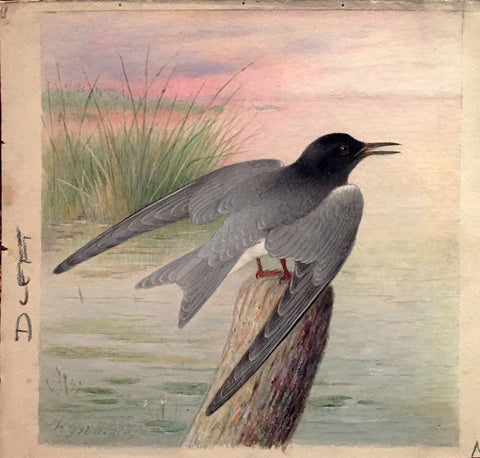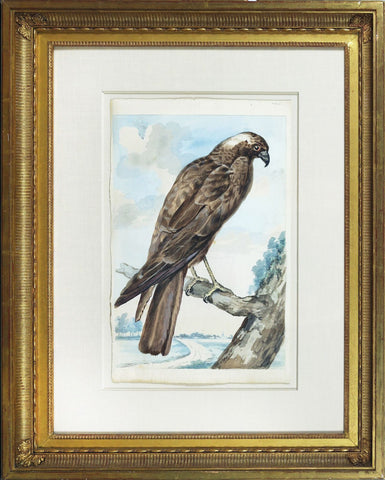
Henrik Grönvold (Danish, 1858 –1940), Hydrochelidon Nigra (Black Tern)
Henrik Grönvold (Danish, 1858 –1940)
“Hydrochelidon Nigra (Black Tern)”
Prepared for Plate XI W.H. Hudson and L. Gardiner, Rare, Vanishing and Lost British Birds (1923)
Pencil and watercolor heightened with gouache, some with touches of gum Arabic on paper
Signed ‘H Gronvold’ l.l.
1922-1923
Paper size: 6 1/16 x 6 3/4 in.
Provenance: Anonymous sale; Christie’s, London, 17 March 1999, lot 149, private collector.
“This most aerial and elegant bird of the sea and inland waters was once excessively abundant in the fen country, where it bred annually, and has been lost to us as a summer resident almost within the memory of men still living. ‘Blue Darr’ was its local name in the Norfolk Broads district; in Lincolnshire it was called ‘Carr-Swallow’ and ‘Carr-Crow.’ Turner (Historia Avium , 1548) spoke of its excessive clamour during the breeding season, which was enough to deafen those who lived near the lakes and marshes it frequented. Pennant, describing the East Fen, visited by him in 1769, speaks of the Black Tern in great flocks, almost deafening one with their clamour. Richard Lubbock, about 1818, wrote, ‘it breeds in myriads at Upton,’ near Acle, Norfolk. It ceased to breed in that county about 1835, from what cause is not accurately known. In 1832 it was still breeding in immense numbers in Crowland Wash, Lincolnshire. In 1853 some birds returned, and two or three nests were found in Hockwold Fen. In 1858 a solitary pair bred at Sutton, Norfolk, laying two eggs, which were taken and the birds shot.
Thus ends the story of the Black Tern as a British resident species. Every year on its migration it comes to Cheshire and to Cornwall, and is not uncommonly seen at that time on the Kentish coast; but the few that revisit our shores stay not to breed. The ‘great clamour’ is a thing of the past. Many of us would now gladly submit to be deafened by it.
‘There is another small bird of this kind called Stern in local dialect, which is so like the sea Lari that it seems to differ from them only in size and colour; for it is a Larus, though smaller than the sea Lari, and blacker. Throughout the whole summer at which time it breeds, it makes such an unconscionable noise that by its unrestrained clamour it almost deafens those who live near lakes and marshes. This I certainly believe to be the bird whose vile garrulity gave rise to the proverb Larus parlavit. It is almost always flying over lakes and swamps, never at rest, but always open-mouthed for prey.’— Turner’s Hisioria Avium.
‘The Black Tern was a regular spring visitor to England before drainage had done away with most of the fens and wet marshes to which it used to resort for breeding purposes; but even in Norfolk the last eggs on record were taken as long ago as 1858, though early in the century the nests of the ‘Blue Darr,’ as the bird was called, might have been found in hundreds on the alder-swamps.’— Saunders’s Manual.
‘The pretty little Black Tern is now, alas, only a visitor to the British Islands during spring and autumn migration. Half a century ago it bred every season in considerable numbers on Romney Marsh in Kent, on many of the Norfolk Broads, and in some of the Lincolnshire fens. It is not known to have remained to build its nest in this country for the last five-and-twenty years; incessant persecution, combined with the drainage of marshes, has driven it away, though it still passes our coasts on its way to and from Denmark and Sweden.;— Seebohm’s British Birds.
‘The Black Tern was dying out as a breeding species in Kent in the early forties and became extinct a few years later. . . In my opinion, if efficient protection could be assured, the Black Tern would once more establish itself as a breeding species, though in the present state of affairs this is highly improbable. Austin (R.S.P.B. Watcher at Dungeness) recollects five or six pairs nesting about twenty-five years ago, but the eggs were all taken for eating, together with those of Gulls and other birds.’— Ticehurst’s Birds of Kent.
‘Though nearly all its ancient abodes have been drained, and for its purposes sterilised these many years past, not a spring comes but it shows itself in small companies in the eastern counties of England, evidently seeking a breeding-place. All around the coast the diminution in the numbers of the remaining species of Terns within the last 50 years is no less deplorable than demonstrable.’— Newton’s Dictionary of Birds.”
HENRIK GRÖNVOLD (DANISH, 1858 –1940)
Henrik Grönvold studied drawing in Copenhagen and worked first as a draughtsman of the Royal Danish Army’s artillery and an illustrator at the Biological Research Station of Copenhagen. In 1892, Grönvold left Denmark for London, employed at the Natural History Museum preparing anatomical specimens. There he became a skilled taxidermist and established a reputation as an artist. He was employed at the Museum until 1895 when he accompanied William Ogilvie-Grant on an expedition to the Salvage Islands. After this expedition, Grönvold worked at the Museum in an unofficial capacity as an artist for decades and only left London to attend an ornithological congress in Berlin.
Grönvold’s illustrations mainly appeared in scientific periodicals such as the Proceedings and Transactions of the Zoological Society, The Ibis, and the Avicultural Magazine. In these publications, he drew plates for William Ogilvie-Grant, George Albert Boulenger, and Michael Rogers Oldfield Thomas, among others. Grönvold also completed numerous plates for Walter Rothschild, many of which appeared in Rothschild’s journal Novitates Zoologicae. Grönvold mostly illustrated birds and eggs, rare and newly discovered species from many parts of the world, and mostly worked in lithographs.
Among the books, Grönvold illustrated is George Shelley’s Birds of Africa, which contained 57 plates, many of which had not been illustrated before. He illustrated W. L. Buller’s books on the birds of New Zealand, Brabourne’s Birds of South America, Henry Eliot Howard’s The British Warblers (1907–14), Charles William Beebe’s A Monograph of the Pheasants (1918–22), and Herbert Christopher Robinson’s The Birds of the Malay Peninsula (1929–76). He completed 600 hand-colored plates for twelve volumes of The Birds of Australia (1910–27) by Gregory Macalister Mathews. Grönvold subsequently provided numerous illustrations for Mathews’ The Birds of Norfolk and Lord Howe Islands … (1928) and A Supplement to The Birds of Norfolk and Lord Howe Islands … (1936).
ORIGINAL WATERCOLORS FOR RARE, VANISHING
AND LOST BRITISH BIRDS
by Henrik Grönvold for William Henry Hudson
William Henry Hudson (1841-1922) was a naturalist, author, and staunch advocate for avian preservation and conservancy. Hudson’s lifelong commitment to protecting the environment stemmed from his youth in Argentina, where he marveled at the beauty of nature, spending endless hours watching the drama of forest and field unfold before him. This idyllic upbringing was beautifully penned in the artist’s work Far Away and Long Ago (1918), which remains a cult favorite amongst many novelists, including Ernest Hemingway, who wrote that Hudson’s book was a must-read for any young writer.
Hudson gravitated to studying birds, which guided his life’s work as an ornithologist and author of numerous tomes on the subject. When he settled in England in 1874, he joined the numerous societies for naturalists of the period and became a founding member of the Royal Society to protect birds.
In 1894, W.H. Hudson produced a leaflet titled Lost British Birds produced for Society for the Protection of Birds. Its purpose was to shed light on thirteen “lost” birds which he defined as those “which no longer breed in this country and visit our shores only as rare stragglers, or, bi-annually, in their migrations to and from their breeding areas on the continent Europe,” to concretely show the effect of industrialism, game hunting, and fashion on the sustainability of certain bird species. This pamphlet was illustrated with 15 rudimentary black and white line drawings by A.D. McCormick. Almost immediately after producing his brochure, Hudson began to collect notes for a future publication that would elaborate upon and update facts on endangered and extinct bird species.
Hudson spent the nineteen-teens and early twenties preparing his next publication. When his notes were organized, and he tapped the celebrated ornithological painter Henrik Grönvold (1858-1940) to produce a sophisticated full-color composition for each bird he intended to discuss at length. However, Hudson suddenly died in 1922 before the publication could come to fruition. Hudson’s colleague, Linda Gardiner, pushed the project forward to see it through in 1923.
Please feel free to contact us with questions by phone at 215.735.8811,
or by email at loricohen@aradergalleries.
We Also Recommend





